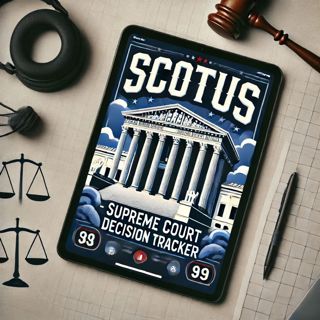
Supreme Court Rulings Reshape Labor, Self-Defense, and Reproductive Rights Landscape
The Supreme Court's rulings this past term have sparked intense discussions and possible long-term consequences, affecting everything from labor relations to individual rights in self-defense scenarios and reproductive rights.In a significant ruling that impacts federal regulatory power, the Supreme Court curtailed the legal protections typically afforded by federal agencies, as seen in their decision regarding Starbucks and the National Labor Relations Board (NLRB). This decision underlines a continuing trend where the Court appears skeptical of the expansive reach of federal regulatory authority, which could influence how agencies enforce laws relating to labor, environment, and consumer protections.Another notable decision came from the Minnesota Supreme Court, which set a precedent in self-defense cases. The ruling made it clear that individuals cannot brandish a deadly weapon in self-defense if there is a reasonable opportunity to retreat. This decision raises questions about the boundaries of self-defense and could influence future cases where the right to self-defense is claimed under urgent circumstances.Additionally, the divisive case of United States v. Idaho regarding abortion care showed the complexities and polarized views surrounding reproductive rights. The case, which was ultimately sent back to the district court, highlights ongoing legal and ethical debates following changes in national abortion laws. This back-and-forth reflects the contentious and often unpredictable landscape of abortion rights in America post the overturning of Roe v. Wade.These decisions from different courts illustrate an evolving judicial landscape where definitions of rights and regulatory reach are actively being contested and redefined. The outcomes not only shape the immediate legal framework but also set the stage for future debates and litigation on what role the judiciary should play in governance and societal norms. As these legal interpretations continue to unfold, they will undoubtedly influence public policy and individual rights across various sectors.This content was created in partnership and with the help of Artificial Intelligence AI
1 Aug 20242min

Supreme Court Rulings Reshape Societal Landscape: Balancing Rights and Community Needs
The U.S. Supreme Court and several state supreme courts have recently issued rulings with significant implications on societal issues ranging from homelessness to environmental regulations and property rights.In one notable decision, the U.S. Supreme Court upheld the authority of cities to enforce regulations against homelessness, interpreting the Cruel and Unusual Punishments Clause narrowly. This ruling has sparked a debate regarding the balance between community management and the rights of homeless individuals under the Constitution. Advocates for the homeless argue that such decisions make it harder for the homeless population to find stability and safety.Meanwhile, the Michigan Supreme Court issued a ruling that touches on the financial outcomes of home foreclosures. The court decided that excess proceeds from the sale of foreclosed homes should return to the former homeowners rather than remaining with the county. This decision could potentially return millions of dollars to Michiganders who lost their homes, aligning with property rights advocates who argue that the previous system was unjustly enriching local governments at the expense of former homeowners.On another front, critiques of the U.S. Supreme Court have emerged concerning its recent decisions impacting environmental and public health protections. Accusations of political leanings influencing the court have become a focal point of discussion, especially in light of decisions that some believe undermine government efforts to protect public goods. Critics argue that such rulings favor business and property rights over environmental conservation and public health.These decisions collectively highlight the complex role of the judiciary in addressing key societal and ethical dilemmas. As each court decision shapes the policy landscape, the public continues to scrutinize the balance the judiciary strikes between individual rights and community needs. The outcomes of these cases demonstrate not only the power of the courts to influence policy but also the diverse philosophies influencing judicial reasoning at different levels of the U.S. judicial system.This content was created in partnership and with the help of Artificial Intelligence AI
31 Juli 20242min

"Courts Reshape Governance and Civil Rights Landscape Across America"
In a trio of influential decisions, courts across America have been actively shaping law that has significant implications on various aspects of governance and civil rights.In Michigan, the state Supreme Court has declared unconstitutional the state's policy of including individuals on a sex-offender registry even if their conviction was for a nonsexual offense. This groundbreaking decision will likely result in hundreds, potentially thousands, of names being removed from the registry. This ruling challenges longstanding practices and underscores a broader legal reassessment of how sex-offender registries are managed, focusing on the relevance and fairness of the crimes listed in relation to sexual offense laws.Meanwhile, on a federal level, a U.S. appeals court addressed a recent U.S. Supreme Court ruling that limited the in-house enforcement powers of federal agencies. This follow-up from the lower court was crucial as it signaled how these agencies should operate within the framework set by the Supreme Court. The ruling is expected to influence a variety of regulatory practices and could potentially reshape the landscape of federal administrative law by redefining the extent of power these bodies have in enforcing regulations without direct court oversight.Adding to the judicial discourse, President Biden has voiced his support for a constitutional amendment aimed at overturning a Supreme Court decision that grants former presidents immunity from certain legal actions. This push by the President reflects an ongoing debate about the balances of power and the accountability of high-ranking officials. This move, if successful, would mark a significant shift in the legal protections afforded to former presidents, aligning with broader discussions on governmental transparency and accountability.These decisions and discussions reflect an evolving judiciary that is responsive to both legal principles and societal values. Each case brings to light the complex interplay between law, policy, and the public interest, shaping the legal landscape in ways that could have long-lasting impacts.This content was created in partnership and with the help of Artificial Intelligence AI
30 Juli 20242min

Biden Unveils Sweeping Supreme Court Reform Plan to Restore Public Trust
In a decisive move aimed at restructuring the United States Supreme Court and restoring public confidence, President Joe Biden recently outlined his proposals for significant changes to the judiciary's highest court. Amid growing concerns over the integrity and the perceived impartiality of the Court, Biden's plan seeks to introduce term limits for Supreme Court justices, a new enforceable ethics code, and a constitutional amendment to revise presidential immunity.The proposal for term limits comes as a response to the lifelong tenure currently enjoyed by Supreme Court justices, which many critics argue can lead to a stagnation of perspectives and a detachment from contemporary societal values. By implementing term limits, Biden aims to ensure a rotation that could infuse the Court with fresh ideas and align it more closely with the evolving democratic principles and diverse viewpoints of the American populace.Additionally, the introduction of a stringent ethics code is intended to hold justices to higher standards of conduct. This aspect of Biden's plan addresses increasing unease regarding the transparency and accountability of the Court's decisions and the need for justices to adhere strictly to ethical guidelines to maintain public trust.Furthermore, Biden is pushing for a constitutional amendment to limit presidential immunity. This initiative suggests a recalibration of the balance of power, ensuring that even the highest office in the country remains within the bounds of judicial oversight. The move comes in the wake of controversial Supreme Court rulings that expanded the scope of presidential immunity, which critics claim entrench executive overreach.These proposed changes by President Biden signal a strong commitment to reforming the Supreme Court in a way that he believes will shore up democratic safeguards and judicial impartiality. However, these reforms will require not only strong advocacy from the administration but also considerable support from a divided Congress, where bipartisan consensus will be necessary to move forward with such structural changes. As the United States stands at what Biden describes as a "breach" in confidence toward its judicial system, these proposed amendments aim to bridge that gap and restore faith in an essential institution of American democracy.This content was created in partnership and with the help of Artificial Intelligence AI
29 Juli 20242min

Roe v. Wade Overturned: States Reshape Abortion Landscape Amid Shifting Judicial and Political Dynamics
With the U.S. Supreme Court's monumental decision to overturn Roe v. Wade, states have gained significant authority on abortion law, leading to rapid legislative changes across the country. Iowa's rigorous stance is echoed by new stringent abortion limitations taking root in over a dozen states, reshaping America’s abortion landscape. This move not only influences women's health and rights but also sends a strong signal regarding state powers over such controversial issues.Simultaneously, actions and decisions during Kamala Harris’s terms as district attorney and attorney general offer rich insights into her approach to criminal justice reform. Harris’s handling of cases involving the death penalty, school truancy, and her support for diversion programs highlight a comprehensive approach that blended toughness with a reformative angle. These positions, reflective of broader prosecutorial discretion and justice policies, came under the spotlight during her rise in national politics and continue to influence perceptions of her policy priorities.Meanwhile, in another state, the Nevada Attorney General's Office is embroiled in legal battles regarding the dismissal of a case involving fake electors from the 2020 election. This appeal underlines the ongoing disputes surrounding election integrity and the aftermath of controversial election results. This case not only underscores persistent tensions in the U.S political landscape but also the role of state attorney generals in impacting national election outcomes.Together, these developments in various states illuminate a multifaceted narrative about American political and judicial environments. From abortion rights in Iowa to criminal justice in California, and election integrity in Nevada, these legal battles denote significant trends and challenges that could shape societal norms and government policies in the coming years.This content was created in partnership and with the help of Artificial Intelligence AI
28 Juli 20242min

"Homelessness Crisis Sparks Sweeping Policy Changes Across America as Courts and Governments Clash"
In a series of consequential movements rippling across the United States, decisions by state leaders and the Supreme Court are reshaping the national conversation around homelessness and judicial legitimacy. Following a pivotal decision by the U.S. Supreme to address what many see as systemic issues in urban areas, state governments are actively adjusting their approaches to address these concerns directly.California Governor Gavin Newsom, in a particularly significant response, issued an executive order directing state agencies to remove homeless encampments across the state. This order came just a month following the Supreme Court's ruling, underlining the swift and direct influence of judicial decisions on state policy actions. Newsom's directive aims to tackle the visible signs of homelessness crisis in numerous California cities, where encampments have become increasingly prevalent.Meanwhile, reactions to the Supreme Court's ruling extend beyond administrative measures. Los Angeles Mayor Karen Bass emphasized that the decision should not serve as a pretext for cities nationwide to sidestep addressing the root causes of homelessness. Her statement reflects a broader concern among civic leaders about using judicial rulings as shortcuts to solving deeply entrenched social issues.This discourse around the Supreme Court's influence also touched local judicial levels. For instance, recent decisions by the Kansas Supreme Court revealed a palpable sense of caution and introspection among its justices. Commentary from within the court hinted at a preoccupation with maintaining the judiciary's legitimacy in the eyes of the public, especially when pivotal judgments come into play.These developments paint a picture of an America at a crossroads, where judicial decisions influence public policy and administration both in direct and indirect ways. With each ruling, leaders at various levels of government are tasked with interpreting and implementing measures that resonate with or react to judicial guidance, reflecting the complex interplay between law and life in America. As the nation continues to navigate these challenges, the actions of its courts and elected officials will undoubtedly remain critical in shaping its social landscape.This content was created in partnership and with the help of Artificial Intelligence AI
26 Juli 20242min

Judicial Decisions Reshape U.S. Legal Landscape: Balancing Individual Rights and Regulatory Powers
The landscape of U.S. jurisprudence is constantly reshaped by the actions and decisions of various courts, including the Supreme Court and other lower courts across the nation. Recent events highlight the dynamic and often controversial nature of legal rulings and their impact on individual lives and regulatory bodies.One such case involves a pivotal decision by the Missouri Supreme Court. Christopher Dunn, whose murder conviction was previously overturned by a St. Louis Circuit Court judge, was slated for release. The judge even threatened the warden with contempt for non-compliance. However, in a last-minute turn, the Missouri Supreme Court halted his release, emphasizing the intricate balance and ongoing legal battles faced by individuals in the criminal justice system.Meanwhile, on a broader legislative and regulatory spectrum, the Supreme Court has been actively deliberating cases that have major implications for governmental agencies. In the Securities and Exchange Commission v. George Jarkesy case, the primary issue addressed by the Supreme Court was whether the SEC or similar bodies have the authority to enforce certain regulations.This decision comes amidst significant legal debates concerning the scope of authority federal agencies possess. For instance, following another major ruling, FTC Chair Lina Khan reassured a group of judges that despite recent judicial decisions potentially curtailing powers (notably the Supreme Court's overturning of the "Chevron deference"), the FTC retains its power to set and enforce competition rules. The Chevron deference was a longstanding judicial doctrine that required courts to defer to a federal agency's interpretation of ambiguous laws concerning its scope of authority.These decisions underline the ongoing tug-of-war between strengthening and limiting the regulatory powers of federal agencies, a central theme in contemporary legal and political arenas. They also reflect a judiciary actively engaged in defining and often redefining the boundaries of law, impacting everything from individual rights to the administrative reach of government entities.The implications of such decisions are profound, setting precedent and guiding future cases that may reshape how laws are interpreted and enforced across the nation. Whether it's the rights of an individual like Christopher Dunn or the regulatory powers of federal entities, the courts continue to be pivotal arenas for debate, decision-making, and the administration of justice. Such high-stakes involvements underscore the enduring importance of judicial interpretation and the ever-evolving nature of law in society.This content was created in partnership and with the help of Artificial Intelligence AI
25 Juli 20242min

Former Mesa County Clerk Tina Peters Faces Legal Setback as Supreme Court Denies Appeal
The U.S. Supreme Court recently denied former Mesa County Clerk Tina Peters’ request to halt her ongoing criminal case, in which she faces serious allegations. Peters, entangled in a legal battle, contends with seven felony charges, including attempting to influence a public servant and criminal impersonation. The charges stem from accusations that she allowed unauthorized access to voting equipment, signaling a significant step in the judicial proceedings against her. This denial from the nation’s highest court allows the case to proceed in Colorado, emphasizing the judiciary's role in maintaining legal accountability, even amidst politically charged cases.Meanwhile, the GOP is vigorously challenging efforts to combat misinformation following a legal defeat at the Supreme Court. This initiative has significantly undermined the structure and efficacy of a network comprising academics, nonprofits, and tech initiatives. These organizations have been focal in studying and mitigating the spread of misinformation, a critical issue in the dynamics of modern information dissemination and public opinion shaping.In another state-level judicial development, the Ohio Supreme Court is set to hear a case involving Senate President Matt Huffman. The case revolves around Huffman's opposition to being deposed in connection with legislative actions he was involved in. Set against the backdrop of Ohio’s political landscape, this case highlights the continual conflict between legislative actions and legal accountability.These distinct cases reflect deeper themes of accountability, the reach of misinformation, and the interplay between politics and the judiciary in the United States. Each case, from federal to state courts, underscores the challenges and complexities within U.S. legal and political spheres, demonstrating how judiciary decisions can have widespread implications on governance, public trust, and the integrity of democratic institutions.This content was created in partnership and with the help of Artificial Intelligence AI
24 Juli 20242min





















